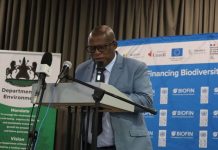Africa-Press – Lesotho. The fast-track land reform of Zimbabwe between 1998 and 2007 was a tremendous movement which caused an international outcry. It tended to be violent towards the whites who were on land.
The land was violently taken from white farmers and given to black Zimbabweans. The effects of that movement are still deeply felt across that country.
The issue of imbalances in the ownership of land between the settler whites and the black indigenous majority is one that runs across the sub-Saharan region.
In Kenya, for example, the well-known Land (and) Freedom Army, popularly known as the Mau Mau, was formed in the early 1950s partly due to land imbalances between settler and native.
Mau Mau protracted an insurgency whose primary objectives were to repossess the land and also to gain national independence until the British government initiated liberation talks with Kenyan leaders in 1960 and independence was achieved in 1964.
In South Africa, while the discriminatory policies affected every aspect of South African life, it was on the access and ownership to land where it was heavily felt.
Black ownership of property, which in most cases is defined by land in either urban or rural areas, was very difficult. African ownership of land was based on communal tenure systems that were promoted by the whites in a manner that strangled Africans.
Successive land laws alienated Africans from their land. The Group Areas Act itself was used to enforce the racial segregation laws in South Africa. Blacks were generally relocated to African “reserves” which were renamed ‘homelands.
’
It is said that when the South African government took over the administration of Namibia in 1920, approximately 12 million hectares of prime land were in the hands of the whites. By 1925, a further 12 million hectares had been given to the whites, mostly Afrikaner farmers.
While large tracts of arable land were being allocated to the whites, the Native Land Commission proclaimed a paltry 2 million hectares for Africans who constituted 90 percent of the population. In Namibia, and South Africa today, the land question is still hanging.
Regardless of the land reform that took place in that country, in Zimbabwe there has been a few literary works which are based solely and broadly on the fast-track land reform (1998-2007), in the manner of Jorge Amado’s The Violent Land of 1943, where the land issue is the author’s sole attention and not just selected events in the background.
This prompted some people in the literary field to ask, ‘Where is the literature of the Zimbabwe land reform?’ The fast-track land reform phase brought Zimbabwe into the international spotlight, arguably much more than the liberation struggle for Zimbabwe itself.
The assumption is that the Zimbabwean writer of fiction is a betrayer in that he does not write about the burning issues of his country. The other assumption is that since you are a writer, you must ‘know everything’ enough to sit down and just write now-now!
So that is why I, Memory Chirere, a published Zimbabwean writer had already gone out much earlier into the field from 1999 to 2000. The great writer, Dambudzo Marechera, had done the same; researching in order to write a book called Scrapiron Blues.
I adopted his methods and went out to see and listen to people and scribble notes in my vicinity of Bindura town in northern Zimbabwe before I could write about the fast-track land reform. I was taking down notes on what the typical actors said and did during the onset of the fast-track land reform of Zimbabwe.
The intention was not only to try and create a historical fictional piece of work out of that but also to work out the implications of the actions and utterances of the fast-track land reform actors had to a writer. These actors are what I often refer to as ‘my targets. ’
As demonstrated before by Tolstoy in the process of writing War and Peace in Russia and Pepetela in the case of Mayombe in Angola, I was aware that to be able to create around any historic event, the writer needs to listen carefully to real people and come to terms with the validity of their utterances and actions before fictionalising them.
I discovered that these actors and characters on the ground were already in search of an author, in the fashion of Luigi Pirandelo’s play of 1921, Six Characters In search of An Author.
In that play, the rehearsal of a play is about to begin, action is unexpectedly interrupted by the arrival of six strange people who explain that they are themselves – unfinished characters in search of an author to finish their story! This was a unique case in Creative Writing where the characters or targets demanded to be ‘created’ in a certain way.
The evaluation of the land reform in Zimbabwe (by Zimbabweans) was playing out viciously in what may seem informal courts like the bars, the weddings, the funerals and other gatherings where, once in a while, individuals utter attitudinal and maybe, factual statements like: Unotora farm yemurungu usina kana badza, unoti ucharima nei? Mauraya the bread basket of Southern Africa! (You grab a white-man’s farm when you do not even have a hoe.
So how will you till the land? You have destroyed the bread-basket of Southern Africa!), Purazi ndinoridii ini zvangu, I am a professional ane basa rake! (Why do I need a farm? I am a contended professional?), Ko nyika yose zvayave maruzevha nhaimiwe! (The land reform has villagised the whole country!)
The assumption is that all our informal utterances are texts and that we are their fortunate and unfortunate authors, writing and rewriting what we have grown to take as fact and rational perceptions. My targets around Bindura were not only demanding to be written about but were also writing out how they read or misread history.
During the fast-track stage of the land reform, Bindura was awash with passersby; men and women of all ages from around Mashonaland Central who moved in teams of 50 to 100 to 150 and sometimes whole villages, as they occupied and parcelled out land willy-nilly on the commercial farms.
They passed through Bindura town to connect routes, to buy groceries and to see relatives and one of their key utterance was (We have come to take the mortar) ‘Tauya kuzotora dhaga.
’ To the employed class of Bindura like teachers, nurses, police officers, clerks, these people initially appeared unpolished and unreasonable and even possessed by evil spirits.
The Tauya kuzotora dhaga language came across as a physical action. It had the image of grabbing something with one’s bare hands, taking it to some other place where it rightfully belonged.
The use of dhaga in that statement was reminiscent of the construction site because ‘dhaga’ and ‘ivhu’ are quite different. Dhaga is mortar, the builder’s paste mixture of soil, cement, sand and water.
It is as if these people were desperately looking to build a mortar and that whatever they had been building was in danger of not being completed because of the shortage.
From a certain angle, this was apt because (from the acute overcrowding) farming space had visibly run out in the nearby TTLs like Madziwa, Chiweshe and Dotito, exactly in the fashion of the running out of building mortar.
Ironically the shortage of land was the major grievance that subsequently led to the war of liberation itself. This being the onset of the fast track land reform, the Bindura audience wondered how this ‘kutora dhaga’ would occur in a legal sense.
In the so-called modern capitalist setting, where land tenure is individual and private, how would one simply say they have come all the way from a village to take prime land? I wondered how I would use these people in a story or poem or novel.
Would I be on the side of my targets? Would I instead portray them as people from an outer space? If I were to go on their side, would I present them truthfully when I was not part of ‘kutora dhaga’? I was supposed to be a mere objective observer.
At some point, I battled with the other question: Should I, the author, stop listening and scribbling and join these people ‘pakutora dhaga’ and write later? I happen to come from the same place as some of these people and had grown up amidst the land shortage grievances which spanned back to the days of occupation.
Then as the author, I was certain that there are two main ways of acquiring land in a traditional Shona society from where the kutora dhaga people came from: (a) an individual obtains land rights by residence.
As long as individuals were politically acceptable in the community/village, they acquired a piece of land after consulting the village headman, who in turn had constant contact with the sub chief or chief.
Once an individual had acquired a piece of land, the community protected his/her rights to its use as long as he continued to use it. When not in use, land reverted to the community.
(b) An individual obtains land through lineage: — In this system, access to agricultural land was exclusively reserved for use by the members who traced their heritage from a common ancestry.
As a rule, transfer of land rights among the Luvale for example was between matrilineal relatives or friends, and the land rights of a deceased person were most likely taken over by a matrilineal relative. So where was kutora dhaga coming from? During this search for a story, I spoke to Johnston Machinjike of Chiweshe (June: 2000).
He said to me: Chamunondibvunza chiiko nhai sakuwana? Ndinonzva naivo asekuru wangu kuti dhaga tikambenge taritorehwa zvitsvenetsvene novarungu pavakauya zvokuti ukatarisa mune maorange mese umu mune makuva edu vanhu veKwaChiweshe.
Kwatinoita uku hudzoka mwachewe! Iri pamusimha ndonjiri. (Don’t ask silly questions, stranger. I understand that we were pushed from all the land around here and if you go around the estates you will find graves upon graves of the people of Chiweshe.
) With the help of hindsight, my target was making an argument. He wanted compensation as land reform.
He was not talking about restitution! According to Virgo Graham, the law of restitution is the law of gains-based recovery. It is to be contrasted with the law of restitution which is the law of loss-based recovery.
Obligations to make restitution and obligations to pay compensation are each a type of legal response to events in the real world. When a court orders restitution it orders the defendant to give up his/her gains to the claimant.
When a court orders compensation it orders the defendant to pay the claimant for his or her loss. My target was not looking for land in order to be productive but as a form of recovery.
He surely deserved such a minimum demand. World History is replete with such stories. This had played out and continues to play out in the territories of the Red Indians in the United States and Aborigines in Australia.
For my target, this was a very emotional moment. My target wanted to seize the moment. My character had no luxury to think if he was right or wrong because he was here to right a historic wrong.
Another statement was: “Muri kungomera pese pese fanika howa” which means (You are just germinating haphazardly like mushroom. ) This statement was uttered by critics of the fast-track land reform programme to describe the mushrooming of farming settlements on farms that legally belonged to white people.
The assumption is why these people got onto the farms without consulting any formal authorities. The occupiers would appear, sometimes unannounced and start to clear land and farming activity would begin.
Soon they would be joined by others and there would be a farm within a farm within a farm. It is at this precise moment that I did a quick sketch of a short story called Maize.
It was first published in Writing Still Weaver Press in 2003. It is a story based on a woman in Shamva during the fast-track land programme that I came across when accompanying a journalist friend.
She was a very beautiful woman staying all by herself in a hut in the middle of a partial clearing where her maize crop was beginning to germinate. We rushed to her hut to avoid the impending storm. I imagined myself coming back to see her on my own under the pretence of having left my luggage in her hut during the first visit.
‘Kungomera sehowa’ (just germinating like mushroom) is a statement coming from a derogatory Shona term ‘mwana wekuhowa’ (child from mushroom gathering spree) More precisely, this means a miracle child who came from a woman who had gone out gathering mushrooms.
Therefore, those who were ‘germinating’ on the farms like mushroom are perceived as upstarts and bringers of tragedy and mishap just like the boy from the mushroom world.
This points at the supposed immorality of the land reform programme since all these settlements are growth without design. It is important that the mushroom signify mythical happenings because mushroom, suddenly springs from the ground.
The land reform in Zimbabwe has proved to me, maybe more than the liberation struggle itself, that when we fictionalise events of our time through song, poetry, novel, sculpture and others, we are challenged to go beyond scripting and sculpting and ask ourselves; who am I in all this?
In an essay of 1987, Dambudzo Marechera himself says: “If brightness can fall from the air, then, as with Heinrich Heine, good poetry is the art of making invisibility visible.
If I am looking at something, and I am conscious of myself looking, does that affect what I see?” Every writer, indeed, is a writer in politics because even if you make the invisible visible, what we see from your work are the conversations that you have done with the subject through what you have privileged or underplayed.
https://www.thepost.co.ls/insight/writers-and-the-land-question/
For More News And Analysis About Lesotho Follow Africa-Press






